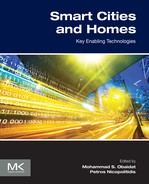Book Description
Smart Cities and Homes: Key Enabling Technologies explores the fundamental principles and concepts of the key enabling technologies for smart cities and homes, disseminating the latest research and development efforts in the field through the use of numerous case studies and examples.
Smart cities use digital technologies embedded across all their functions to enhance the wellbeing of citizens. Cities that utilize these technologies report enhancements in power efficiency, water use, traffic congestion, environmental protection, pollution reduction, senior citizens care, public safety and security, literacy rates, and more.
This book brings together the most important breakthroughs and advances in a coherent fashion, highlighting the interconnections between the works in different areas of computing, exploring both new and emerging computer networking systems and other computing technologies, such as wireless sensor networks, vehicle ad hoc networks, smart girds, cloud computing, and data analytics and their roles in creating environmentally friendly, secure, and prosperous cities and homes.
Intended for researchers and practitioners, the book discusses the pervasive and cooperative computing technologies that will perform a central role for handling the challenges of urbanization and demographic change.
- Includes case studies and contributions from prominent researchers and practitioners from around the globe
- Explores the latest methodologies, theories, tools, applications, trends, challenges, and strategies needed to build smart cities and homes from the bottom up
- Provides a pedagogy that includes PowerPoint slides, key terms, and a comprehensive bibliography
Table of Contents
- Cover
- Title page
- Table of Contents
- Copyright
- Dedications
- List of Contributors
- About the Editors
- Preface
- Acknowledgments
- Chapter 1: Introduction and overview of key enabling technologies for smart cities and homes
- Chapter 2: Wireless sensor networks applications to smart homes and cities
- Chapter 3: Software defined things: a green network management for future smart city architectures
- Chapter 4: Nomadic service discovery in smart cities
- Chapter 5: A survey on enabling wireless local area network technologies for smart cities
- Chapter 6: LTE and 5G systems
- Chapter 7: Cars as a main ICT resource of smart cities
- Chapter 8: From vehicular networks to vehicular clouds in smart cities
- Chapter 9: Smart home cybersecurity considering the integration of renewable energy
- Chapter 10: Smart home scheduling and cybersecurity: fundamentals
- Chapter 11: Advanced optical network architecture for the next generation internet access
- Chapter 12: Cloud computing systems for smart cities and homes
- Chapter 13: Design and management of vehicle-sharing systems: a survey of algorithmic approaches
- Chapter 14: Smart transportation systems (STSs) in critical conditions
- Chapter 15: Optimization classification and techniques of WSNs in smart grid
- Abstract
- 1. Introduction
- 2. Optimization primer
- 3. Types of objectives and optimization techniques in smart grid paradigm
- 4. Constraints considered while formulating optimization problems in smart grid paradigm
- 5. Optimization solution types and related simulation tools in smart grid paradigm
- 6. Conclusions and discussions
- Chapter 16: Docit: an integrated system for risk-averse multimodal journey advising
- Chapter 17: Smart restaurants: survey on customer demand and sales forecasting
- Author Index
- Subject Index
